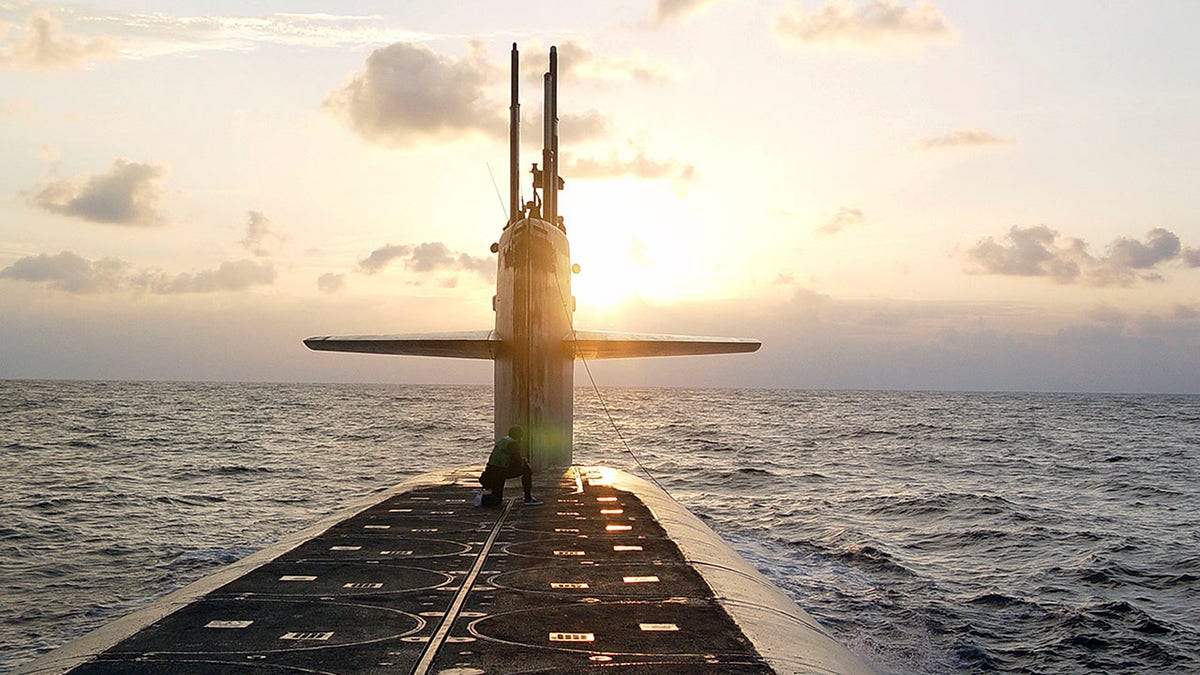Fox News Flash top headlines for November 11
Fox News Flash top headlines are here. Check out what's clicking on Foxnews.com.
They will secretly patrol the dark corners of the undersea, quietly tracking enemy movements sustaining a persistent threat of nuclear annihilation against anyone willing to launch a catastrophic first strike on the U.S. homeland.
Assured destruction keeps the peace … the fundamental paradox of nuclear strategic deterrence, a strategy well underway by the Pentagon seeking to launch a new fleet of high-tech, heavily-armed ballistic missile submarines tasked with ushering in a new era in nuclear deterrence.
The Navy has awarded a $9.5 billion deal to General Dynamics Electric Boat to build the first two Columbia-class nuclear-armed submarines, a monumental step toward ultimately building as many as 12 new boats to replace the aging Ohio-class. The first submarine is scheduled for delivery to the Navy in 2027, and the second one in 2029.
The 560-foot boats will be armed with Trident II D5 nuclear missiles, fly-by-wire, computer-generated navigational controls, a stealthy X-shaped stern and ultra-quieting “electric drive” propulsion. The concept with the Columbias is to not only architect something that will be upgraded to accommodate new nuclear missiles as they emerge, but also to construct the stealthiest submarine ever to exist. After all, remaining “undetected” is the whole point of undersea strategic deterrence, something which could correctly be characterized as an ability to maintain the ability to destroy entire cities, even countries, from undisclosed, unknown locations.
NAVY ELECTRONIC WARFARE STOPS MULTIPLE ENEMY MISSILE ATTACKS AT ONCE
The advent of newer kinds of more sensitive sonar, undersea drones, laser scanners and yet-to-exist methods of submarine hunting are increasingly making it much harder for submarines to remain undetected.

2008: The Ohio-class ballistic-missile submarine USS Wyoming approaches Naval Submarine Base Kings Bay, Ga. (Lt. Rebecca Rebarich/U.S. Navy via AP)
The new class of submarines, slated to serve well into the 2080s or even beyond, may grow beyond the 12 planned boats, depending upon how various threats evolve. The Columbia’s will have a longer mission life by virtue of being engineered with a “life-of-core” nuclear reactor, a system which means a boat will not have to return to dock for lengthy refueling. This of course extends mission life and therefore optempo for the submarines. The new class will also incorporate some elements of the ultra-high-tech Virginia-class submarines such as a fiber optic cable for periscope viewing and semi-autonomous joystick-type controls to replace the older hydraulic systems.
Many see the need for these new boats as nothing short of urgent, and the Pentagon has for years cited the Columbia-class submarine effort as DoD’s number one acquisition priority, given that the existing Ohio-class boats have served for decades beyond the original intention.
China’s rapid construction and weaponization of its new JIN-class ballistic missile submarines is also, not surprisingly, driving the effort. The PLA Navy is adding new submarines and also testing a new, even longer-range JL-3 nuclear-armed missile. The existing JL-2s have a strike range as far as 4,000 miles, enabling Chinese submarines to hold larger areas of the continental U.S. at risk of nuclear attack.
NAVY ARMS SEA DRONES FOR OCEAN ATTACK
In today’s Ohio-class submarines, a reactor plant generates heat which creates steam, Navy officials explained. The steam then turns turbines which produce electricity and also propel the ship forward through “reduction gears” which are able to translate the high-speed energy from a turbine into the shaft RPMs (Revolutions Per Minute) needed to move a boat propeller.
“The electric-drive system is expected to be quieter (i.e., stealthier) than a mechanical-drive system,” a Congressional Research Service report on Columbia-Class submarines from earlier this year states.
https://crsreports.congress.gov/product/pdf/R/R41129/174
Designed to be 560 feet long and house 16 Trident II D5 missiles fired from 44-foot-long missile tubes, Columbia-Class submarines will use a quieting X-shaped stern configuration. The “X”-shaped stern will restore maneuverability to submarines; as submarine designs progressed from using a propeller to using a propulsor to improve quieting, submarines lost some surface maneuverability, Navy officials explained.
Navy developers explain that electric-drive propulsion technology still relies on a nuclear reactor to generate heat and create steam to power turbines. However, the electricity produced is transferred to an electric motor rather than so-called reduction gears to spin the boat’s propellers.
NAVY TESTS NEW SLEEK, STEALTHY DESTROYER HULL IN ROUGH SEAS
The use of an electric motor brings other advantages as well, according to an MIT essay written years ago when electric drive was being evaluated for submarine propulsion.
Using an electric motor optimizes use of installed reactor power in a more efficient way compared with mechanical drive submarines, making more on-board power available for other uses, according to an essay called “Evaluation and Comparison of Electric Propulsion Motors for Submarines.” Author Joel Harbour says that on mechanical drive submarines, 80% of the total reactor power is used exclusively for propulsion.
CLICK HERE TO GET THE FOX NEWS APP
“With an electric drive submarine, the installed reactor power of the submarine is first converted into electrical power and then delivered to an electric propulsion motor. The now available electrical potential not being used for propulsion could easily be tapped into for other uses,” he writes.
-- Kris Osborn is the Managing Editor of Warrior Maven and The Defense Editor of The National Interest --





















